The Himalayan Cock Fight
Article by Liz Cleere ,
Photos by Jamie Furlong
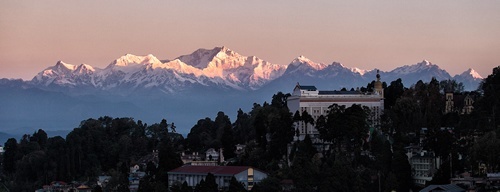
|
|
The Himalayas frame the village. Photo by Jamie Furlong.
|
At only three years old, they are the tiniest children here. They look at each other, then at the crowd, eyes wide and mouths turned down. Amid the children, a referee makes them stand up straight with their backs against a measuring stick. From our position, it is unclear if they should be above or below his mark. The children are pushed and prodded back and forth within a three-meter circle of dusty earth until the official decides what they will do. There are eight of them, three girls and five boys. Some hold hands quietly while others jump up and down, anticipating what will come, but they all remain silent as the grownups fuss around them.
"NEXT WILL BE THE COCK FIGHT!" The PA announcer screeches through the distorted sound system. There is not even a murmur from the audience. Jamie and I raise our eyebrows at each other.
"Cock fight?" Jamie whispers.
"Or was it 'dog fight'?" I answer.
Jamie, my partner, is a vegetarian. I like my steak rare, but I don't think I can even watch animals fighting for sport, no matter how usual it may be in this part of the world. As there is no sign of a revved-up chicken or crazed slavering dog yet, we do what we always do, sit and wait to see what will happen.
It is November, and although unseasonably warm for the Himalayan foothills of Kalimpong, the children wear several layers of clothing. The students are all from the youngest class of one of the schools and look very sharp in red and grey. They cast bewildered glances at each other as the grownups come at them again, this time lifting up the back of their jumpers to fix a length of the string — to which a balloon is tied at the other end — onto each waistband. It's a fiddly process, but the children raise no objection and remain silent as they undergo this indignity.
When the last balloon is fixed to the back of the smallest boy, the adults exit the circle, leaving a knee-high knot of children in the middle. A whistle blows. Suddenly, the biggest boy grabs the balloon of the smallest and prettiest girl and squeezes it with all his strength until it pops! She races from the circle towards her mummy, seemingly relieved to escape the ordeal. There is a collective intake of breath from the crowd, then a wave of laughter and recognition ripples around the sports ground. So this is the game. The last one with a balloon wins. Now that the other kids have the idea, they try to grab each other's balloons. Round and round, they turn, and like a circus ring, the next few minutes are taken up with dodging, jumping, hopping, grabbing, pulling, stamping, and a great deal of falling over. It is the funniest event we have seen all day. In fact, everyone laughs except the children. It is a deadly serious event for them, and they are all intent on winning. Eventually, the big boy wins, but only because the other contender fell over and burst his own balloon. The story ends happily, with all the children taking a bow amid laughter and applause from the audience.
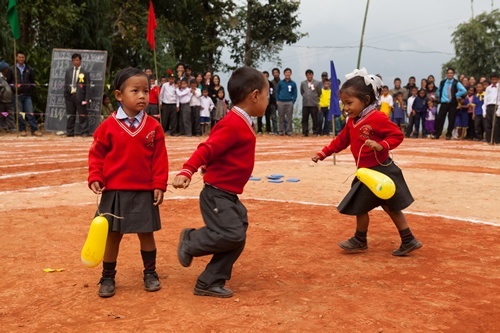
|
|
Children playing a balloon game. Photo by Jamie Furlong.
|
Jamie and I are among the guests of honor at the Schools Inter Sports Competition, sponsored by the Mondo Challenge Foundation. It is being held at the Alpha Nursery, one of six schools in Kalimpong district, West Bengal. Earlier in the day, we watched the schools line up and march around the field, accompanied by their marching bands and flag bearers. Ranging from ages four to eleven, they marched with heads held high and severe expressions. Sitting next to us were two elderly Gorkha ex-soldiers wearing medals on their lapels. They had pens and paper and made notes as each school marched past.
“Is this part of the competition?” I asked Jiwan, the Foundation's local representative and manager.
“Oh yes, they were both Subidars in the Indian army. They know a lot about marching.”
* * *
A year before the sports day, our friend Amy volunteered at the Magno Vale Academy in the mountains near Darjeeling. She spent eight months in tiny, cold classrooms, teaching English to children from four to 16 years old. There was often no electricity, and she had only a blackboard as a teaching aid. Before returning to the UK, Amy visited us in Cochin. She described in detail the poor education and facilities she found in the remote mountain villages of this region of India. We poured over her photographs and learned all about the area's children, teachers, and families. When Amy returned home to the UK, she began finding and raising sponsorships for the school.
Amy's enthusiasm was contagious, and it didn't take long after she left for us to decide we wanted to help somehow. Not being able to volunteer, we concluded the best way to make an impact would be to write about the work on our websites and through social media. With just enough time to get to the northeastern Himalayas before the monsoon began, we set off from the humid heat of Kerala.
Before we left, the charity's founder, Anthony Lunch, heard that we would visit Amy's school and press-ganged us into acting as "ambassadors" for the Foundation. Should we report back on what we find? We were happy to be of help.
We arrived in the beautiful hill station of Darjeeling and, after a plate of Tibetan momos (dumplings), managed a good night's sleep before heading off the next day to Magno Vale Academy in neighboring Sukhia Pokhri.
Jiwan Rai drove us over rock-strewn roads that twisted their way above shear passes on one side and pastel-colored timber and dung houses on the other. Some dogs we zoomed past chased his little car and barked furiously.
“They were traffic police in a past life,” he told us with a twinkle in his eye.
The road turned into a dirt track. Jiwan parked in a shallow ditch, and we left the car and walked in single file down a rocky path to the school. When we reached the end, we climbed over a slippery stone wall into the playground (the path and wall were later washed away during the monsoon, closing the school for a week). The building was half completed, with some classrooms having no glass in the window frames while others had no plaster on the walls. There was a precarious attitude towards electricity, but oblivious to the deprivation, the children (aged four to 16 years) gave us a warm welcome.
“Some of them walk for three hours to come here every day,” said the energetic young headmaster Deven Subba.
“They walk up through the fields and forests. There are no roads.” He pointed across the valley. “Most of the children’s parents work in the tea or quinine plantations and can’t read or write.”
Deven introduced us to a class of 7-year-olds, all keen to show us their bookwork. In fact, the entire school was eager to meet us, so we made a point of visiting each class. With saucer eyes, the children drank in everything we said. We played games, swapped stories, listened to them sing, and watched long and intricate dances.
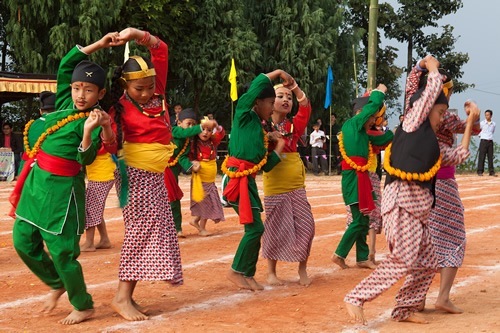
|
|
Children enjoying traditional dances. Photo by Jamie Furlong.
|
We spent the final hour with the top class. Six pupils, ranging from 14 to 16, were taking more advanced lessons. We were astonished by their high level of spoken and written English skills and asked them if they had any questions. In the UK, we might have expected questions about the X Factor, Big Brother, or the latest football shenanigans, but we were surprised by the topics these teenagers raised.
“Do you think Osama bin Laden is really dead?” (The news the previous week had been about the US hit on bin Laden’s fortress in Pakistan.)
“Do you believe in the Big Bang theory?”
“Has man finished evoluting [sic]?”
They challenged our knowledge of current affairs, made us articulate arguments, and sparked ideas we had not considered for a while. It was an interesting hour. (Do you believe aliens have ever visited the earth, and if so, what's your evidence?) We wanted to stay longer, but Jiwan wondered if we would like to see the two other Darjeeling district schools supported by the Foundation. Of course.
When it was time to leave, we were given a happy send-off by both the children and the teachers, all asking when their next volunteer would arrive; they missed Miss Amy. We promised we would tell Anthony to send someone soon.
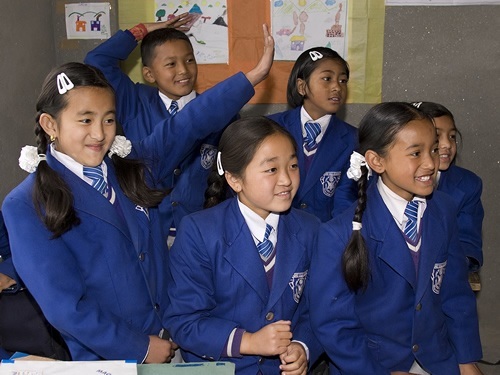
|
|
Children saying goodbye. Photo by Jamie Furlong.
|
It was the same story at Sacred Heart and RIBS, the other two small village schools in the area: lack of funding, poor facilities, dedicated teachers, and eager children. Everyone wants to see more volunteers and to interact with people from overseas.
“The route to success, and any chance the children might have for improving their lot, comes from learning English,” explained Jiwan. “That is why we put such emphasis on both reading and writing. Once they reach the age of five all their lessons are in English.”
* * *
The sports field lies on the edge of a high ridge above Barranumber, overlooking the Alpha Nursery School. The fields and jungle drop into the river valley a kilometer below us. In the distance, we can see Sikkim and Nepal. The common language of all the tribes (Lepcha, Limboo, Rai, Tamang, Tenzing, Bhutia, and more) who live in the Himalayas is Nepali. The fiercely fought borders drawn on maps by diplomats, kings, and politicians mean nothing to the people of this region.
* * *
At RIBS primary school in Manebhanjang, Darjeeling district, Pramod, the headmaster, wondered if we'd like to go to Nepal for lunch. We had just spent the morning talking to his bubbly pupils, aged three to 10, and were ready for a break. So we strolled up the road, nodding to the disinterested border patrol guards, and jumped over a storm drain into Nepal. It hardly felt like moving into another country. Still, the thrill of defying the rules turned lunch into a small adventure.
Over a few illegally obtained Nepali beers and nefarious noodles with our new friends, we asked where we should go for the best view of Kanchenjunga, India's highest peak.
“Avoid Tiger Hill,” said Jiwan. “Hundreds of those noisy Indian tourists go there by Jeep every morning."
Instead, they insisted we try to get to 10,170ft Tonglu because it offers a slightly closer and clearer view.
"It’s also a very pleasant morning's walk," said our friend Jiwan over the rim of his beer glass.
It didn't take them long to convince us that despite our creaky knees and general lack of fitness, we would easily manage a two-day trek in the Singalila National Park. By the time we arrived back in India, they had arranged for Pemba, a recently qualified guide, to accompany us.
“After you come back I will introduce you to our schools in Kalimpong and you will stay at my family's home in Barranumber,” announced Jiwan.
OK.
So before the promised visit to the other six schools we took a brief trek in the mountains “to get a better of idea of what it is like to live here.”
Our guide was a 21-year-old local student eager to practice his new job and excellent English on us. We were delighted to be his guinea pigs. We soon learned, however, that the Nepali idea of a leisurely walk is quite different from our own (or perhaps Jiwan's mischievous sense of humor stretched to sending his friends on grueling tests of stamina). The first day included the steepest part of the trek and took eight hours. It drizzled. It thundered. Lightning crashed all around us. Darjeeling is named the "Land of Thunderbolts" for good reason. It rained during the entire journey.
At Tumling, after a toasty night under thick blankets in an unheated mountain hut, Jamie dutifully got up before dawn for a hike up to Tonglu, hoping to catch the sun hitting Kanchenjunga through his lens. Unfortunately, this vision lasted only a few seconds before the clouds lumbered across the horizon, gobbling up the mountain and valley.
We stopped at Chitray ("Bamboo House") in the drizzle on our way back. It was a welcoming pit stop comprised of a collection of timber and bamboo buildings that make up a farm, complete with goats, dogs, and chickens mooching around the yard. The most prominent building doubles as a family home and walkers' canteen. We fell into the warm, dimly-lit room, steam pouring off us, where we knocked back masala chai while munching on biscuits. After a while, a young Lama and his entourage of Tibetan monks arrived and were ushered into the back room with great respect and much bowing. An older man sitting in the shadows between the kitchen and dining room smiled and raised his glass to us, so we nodded and waved hello back. With Pemba translating, we learned some of his story.
He was 80 years old. 58 years previously, he was imprisoned in Tibet by the Chinese. He knew he would never get out alive, so after 12 days, he escaped, taking his mother and father with him. He didn’t know how many miles they had walked over the mountains, but he reckoned it took two months to get here, where they built their first farm out of local bamboo.
He finished his coffee and went off to be blessed by the Lama. Then he shouted goodbye to us and set off up the hill in the rain. We watched him disappear into the mist, carrying a heavy corrugated iron on his back.
“He’s going to mend one of the shacks on his farm,” Pemba told us.
* * *
There are no signs of evil chickens or pugilistic puppies for the cock/dog fight, so Jamie and I put the announcement down to a misunderstanding on our part.
Instead, we watch several hard-fought relays around the outer track. Batons are dropped, runners fall over, and there are tears of frustration, but in the end, all is forgiven, and the teams' places are entered into a big book on the judge's table. Each race brings enormous cries of encouragement from the participating schools, and we can't help noticing that two of them are much larger and better represented than the others. Nobody seems to mind.
* * *
The six Kalimpong schools were too far from Darjeeling to visit in one day, so we accepted Jiwan's invitation to stay in his family home in the mountains. Alpha Nursery, the smallest of the six schools, is located in the village of Barranumber, right next to Jiwan's house.
Like most settlements in this region, the village clings to the side of a mountain miles from any passable road. The only way to get there is by uncomfortable 4WD or trek beside the quinine plantations and through the jungle surrounding Kalimpong. This time, we equipped ourselves with walking boots, sensible trousers, and waterproofs. I carried bottled water, cans of beer, a few bananas, biscuits, hats, a good book, a torch, toilet paper, matches, incense sticks, mosquito coils, spare sheets, and the kitchen sink. Jamie carried his camera bag.
We were prepared for vertical climbs, knee-wrenching drops, and driving rain, but the weather was sunny and dry, and the walk was a gentle afternoon stroll. We walked in single file, Jiwan in front, me in the middle, and Jamie lagging behind with his camera. The trees and undergrowth beside the trail twittered, clicked, chirped, stridulated, buzzed, fluttered, hissed, and rustled with life. Stopping on a narrow path with views down into the Rangpo Valley, we could see the river sparkling below in the afternoon sun.
"Next time you come we will make a camp, catch fish and have a picnic on the riverbank together."
As we entered the village, we passed a gardenia bush with a scent that was so heady that it obliterated all its competitors. The top noses at Dior couldn't come up with a more intoxicating fragrance.
Houses in the mountains are hand-constructed from wooden frames using local trees. Latticed bamboo is then fixed between the frames and filled with cow dung. At first glance, they are indistinguishable from our wattle and daub buildings at home. The roses, geraniums, and other English herbaceous border flowers arranged outside in pots only add to the familiarity. Sometimes, the exteriors are painted in pastel shades. A slip in the interior is painstakingly smoothed over the walls to create an even finish. The roofs are made of corrugated iron or aluminum. Still, as they are painted over in a terracotta color, they blend in well with the woody surroundings.
At the Rai family home, we drank tea and talked about the village of Barranumber. It contains 90 households, and most of its inhabitants work in the quinine plantations for about 2500 INR per month (around £24 or US$30), supplementing their incomes by growing crops on the terraced hillside. But, like everywhere else, changes in the world's climate have reached this small mountain enclave.
"One year recently we had hail stones for two hours," said Premika, Jiwan's sister, "and the villagers lost all their crops."
However, they have had some good luck due to a donation from the Mondo Challenge Foundation. This meant they were able to build their own school a few years ago. All the children from the valley now have an education, at least up until the age of 11.
In the evening, we watched Jiwan's sister-in-law, Kabita, stoke the hearth in preparation for dinner. Jiwan's family kitchen is coated in yellow-ochre smooth cow dung, the low double range appearing to grow out of the floor. Its two open fires gave off plenty of smoke as Kabita's husband, Santa, cooked the food directly on the flames. We sat on ankle-high stools in the semi-darkness to eat fresh momos, noodles, and pork. Santa plied us with "tiger's milk," a gently fermented maize left to work its magic in a bucket. We moved on to "tongba" (millet beer), then "rakshi" (pronounced "roxy"), a hot version of schnapps, before falling into bed.
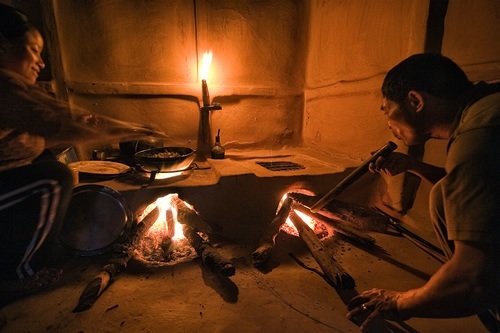
|
|
Cooking food in the flames. Photo by Jamie Furlong.
|
* * *
During our first trip to the schools, it became increasingly apparent how important the children were to meet native English speakers. They are fascinated by other cultures and enjoy interacting with visitors. We wondered if it might be possible for Amy's school to twin with a junior school in the UK. Through social media and direct contact, we put out calls for schools in the UK to be willing to twin with a school in the Himalayas. Jude Savill, an old school friend of Jamie's and now a schoolteacher at Newport Primary School, was touched by the images and reports we published on our blog and volunteered her class for the project.
They only had a little time, but Deven's young pupils got a hand-made pack of letters, drawings, and photographs for us to return to the UK before we left West Bengal.
One morning in July, just before Newport Primary School broke up for their summer holiday, we took the treasured package into Year Five's class. These sophisticated children were visibly touched by the photographs and letters. They were glued to the videos we showed them of the children singing and dancing. They were shocked at the "poor" conditions in which their counterparts were taught and wondered why anyone would bother to walk an hour and a half to school through fields and jungle. Despite the enormous differences in their cultures and lifestyles, they found common ground in humor: Jamie's video of Swapnil wiggling his ears while all his friends giggled had exactly the same effect on the British children. Among all the letters we received thanking us for coming in to talk to them about Magno Vale Academy, one remark from 9-year-old George particularly resonated.
“Can you send us another video of the Indian children? I felt that if I met up with those kids we would get on.”
* * *
Jiwan and his brother Santa come to sit with us as the day starts to wind down. The speeches, awards ceremony, and celebrations will go on for another hour, and Jamie and I will take turns to shake hands with the proud winners. Afterward, we'll have a whisky in the village with the shiny-faced bigwigs, all of whom will be thrilled with the day's success. It has brought more people from the villages together in one place than anyone can remember. Back at the sports ground, the remaining stragglers will knock back as many HITs (local beer) as they can before the day is finished. Then we'll drive back to Kalimpong with Jiwan, staying in his family townhouse. More rough wine and local whisky will be passed around as everyone will help prepare the home-cooked dinner, and we'll end another visit to this beautiful country.
But before all that, the PA system bursts into life, "AND NOW THE COCK FIGHT!"
This time, we know we have heard correctly. Could these dear friends of ours really be intending to have a cock fight on a children's school sports day? We look around the ground, but nothing is happening except a group of six barefoot little boys standing in the gravel circle, no more than four feet high and thin as sticks. Or rather hopping. They each hold one foot high up behind them. Relief washes over us as the little boys start jumping around the circle, mimicking the movement of cockerels. As the crowd eggs them on, they begin to bash into each other. It may not be safe or particularly desirable for eight-year-olds to bash each other into oblivion in the UK. Still, in the mountains, everyone cheers on their favorite player.
|
For More Information
Mondo Challenge Foundation in India has the aim and mission, “Long-term sustainable communities enriched by quality education and livelihood opportunities... We aim to provide high quality education for children in Indian communities; to enable livelihood opportunities within these communities; and to motivate the children to progress as far as possible with their education and contribute back to their communities."
|
Liz Cleere has been sailing and traveling with Jamie and their cat, Millie, since 2006, when they started out in Turkey. They write and record podcasts about their adventures at followtheboat.com.
|
